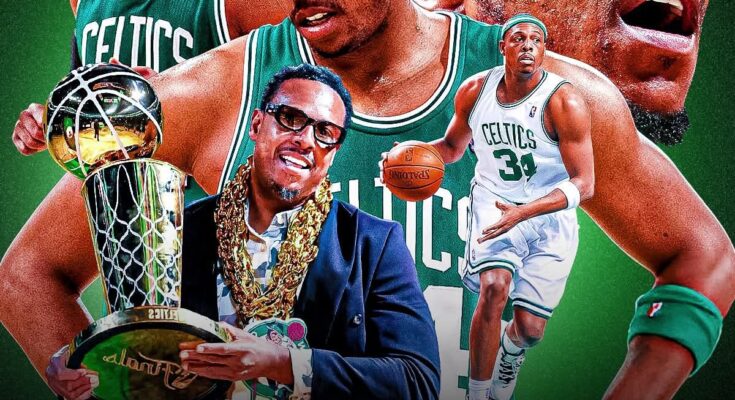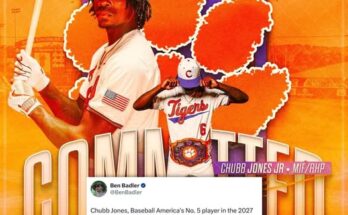Paul Pierce Opens Up On Celtics Legacy Explaining Why Wearing The Green Jersey Is Unlike Anything Else In All Sports
Paul Pierce has never been one to shy away from speaking his mind, especially when it comes to his love and loyalty for the Boston Celtics. Known affectionately as “The Truth,” Pierce carved out one of the most decorated careers in franchise history, but he believes his greatest accomplishment is not in the numbers or the accolades. Instead, it lies in the understanding of what it means to wear the green. On a recent appearance on Games with Names, Pierce reflected on the weight of donning a Celtics jersey, calling it unlike anything else in all of sports.
“You’re talking about the most historical franchise,” Pierce said, his voice laced with both pride and reverence. “It’s more than just basketball. When you put on that jersey, you’re representing not just yourself, not just your team, but an entire legacy of greatness. The legends who came before you, the standard they set—it lives in that jersey.”
For Pierce, the reminders were constant. The presence of icons like Bill Russell, John Havlicek, and Bob Cousy remained a part of daily Celtics life. Even in retirement, those legends made it a point to return to the gym, talk to players, and ensure that the championship standard never wavered. It was a living, breathing tradition, and Pierce embraced it wholeheartedly. Few players understood the magnitude of Celtics basketball like him.
Pierce’s own story is the embodiment of resilience, loyalty, and destiny fulfilled. Growing up, he wasn’t a Celtics fan. In fact, as a native of California, Pierce was raised on the purple and gold of the Los Angeles Lakers, Boston’s fiercest rival. To end up not only wearing the green but becoming one of the franchise’s most beloved stars is an irony not lost on him. But destiny has a way of surprising you. By the time Pierce finished his career, there was no doubt his heart belonged to Boston.
His path to glory wasn’t without adversity. In September of 2000, Pierce’s life nearly ended when he was stabbed 11 times during an incident at a Boston nightclub. Few could have blamed him if he had walked away from basketball entirely, but Pierce returned with a renewed sense of purpose. Instead of deterring him, the near-tragedy strengthened his bond with the city and its people. He had endured pain, fought for survival, and chosen to stand tall. Boston respected him for it, and in turn, he gave everything he had to the Celtics organization.
That bond culminated in 2008, when Pierce, alongside Kevin Garnett and Ray Allen, led the Celtics to their 17th NBA championship. For a city that had waited 30 long years since its last banner, it was nothing short of redemption. Pierce’s performance in those Finals earned him the MVP award, an accolade that stamped his place in Celtics history forever. In those moments, Pierce was no longer the kid who grew up rooting for the Lakers. He was the symbol of Boston’s return to glory, a warrior who carried the torch of tradition and restored the franchise to its rightful place at the top of the basketball world.
What made it even more significant was the way he embraced every bit of the responsibility. Wearing the green is not for everyone. The expectations are massive, the spotlight never dims, and the ghosts of greatness are always looming. For some, that weight is too heavy. For Pierce, it was motivation. “I understood what it meant to be a Celtic,” he said. “It’s not just about winning games—it’s about carrying the values, the toughness, the pride. That’s brotherhood. That’s history.”
In the years since his retirement, Pierce has continued to embody those values, speaking often about what separates the Celtics from every other team. To him, it is the fusion of past and present, the relentless pursuit of excellence, and the unshakable connection between the team and the city. When you step onto the parquet floor of TD Garden, you’re not just another athlete playing another game. You’re stepping into history, surrounded by the echoes of Russell’s dominance, Havlicek’s hustle, Bird’s brilliance, and countless others who defined basketball greatness.
The Celtics’ mystique is woven into every thread of the jersey, every banner hanging in the rafters, every fan who fills the arena wearing green and white. And Pierce knows that mystique is not handed out freely—it must be earned. Through his loyalty, perseverance, and ability to rise when it mattered most, he earned it.
The 2008 championship remains one of the defining chapters of Boston sports, but Pierce’s legacy goes beyond one banner. It is about embodying the essence of Celtic pride. He didn’t chase brighter lights or bigger markets. He stayed loyal through rebuilding years, through heartbreaks, through criticism. He carried Boston through dark stretches and brought them back to the mountaintop. That is why the city embraced him as one of its own, despite his roots in Los Angeles.
Today, when Pierce speaks about the Celtics, it’s with the authority of someone who lived the journey from both sides—the struggles and the triumphs. He understands better than anyone that being a Celtic is about more than basketball. It’s about resilience in the face of adversity, loyalty when it’s easier to walk away, and the pursuit of greatness even when the odds are stacked against you.
As the NBA continues to evolve, and new stars rise and fall, the essence of Celtics basketball remains timeless. Paul Pierce is now one of the voices reminding the next generation what it means to wear the green. He represents the bridge between eras, ensuring that the fire of Celtic pride burns just as brightly today as it did in Russell’s time or Bird’s reign.
For Boston, it will always be about more than just the game. It is about history, family, and carrying the weight of basketball’s greatest tradition. And for Pierce, it is about gratitude—gratitude for the city that embraced him, the teammates who fought alongside him, and the legacy that he now shares with the greatest to ever play the sport.
Paul Pierce may not have been born into Celtic green, but he became one of the truest examples of what it means to wear it. Through loyalty, resilience, and triumph, he etched his name among the immortals, ensuring that when future players put on the jersey, they’ll remember exactly what he said—wearing the green is unlike anything else in sports.



